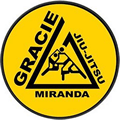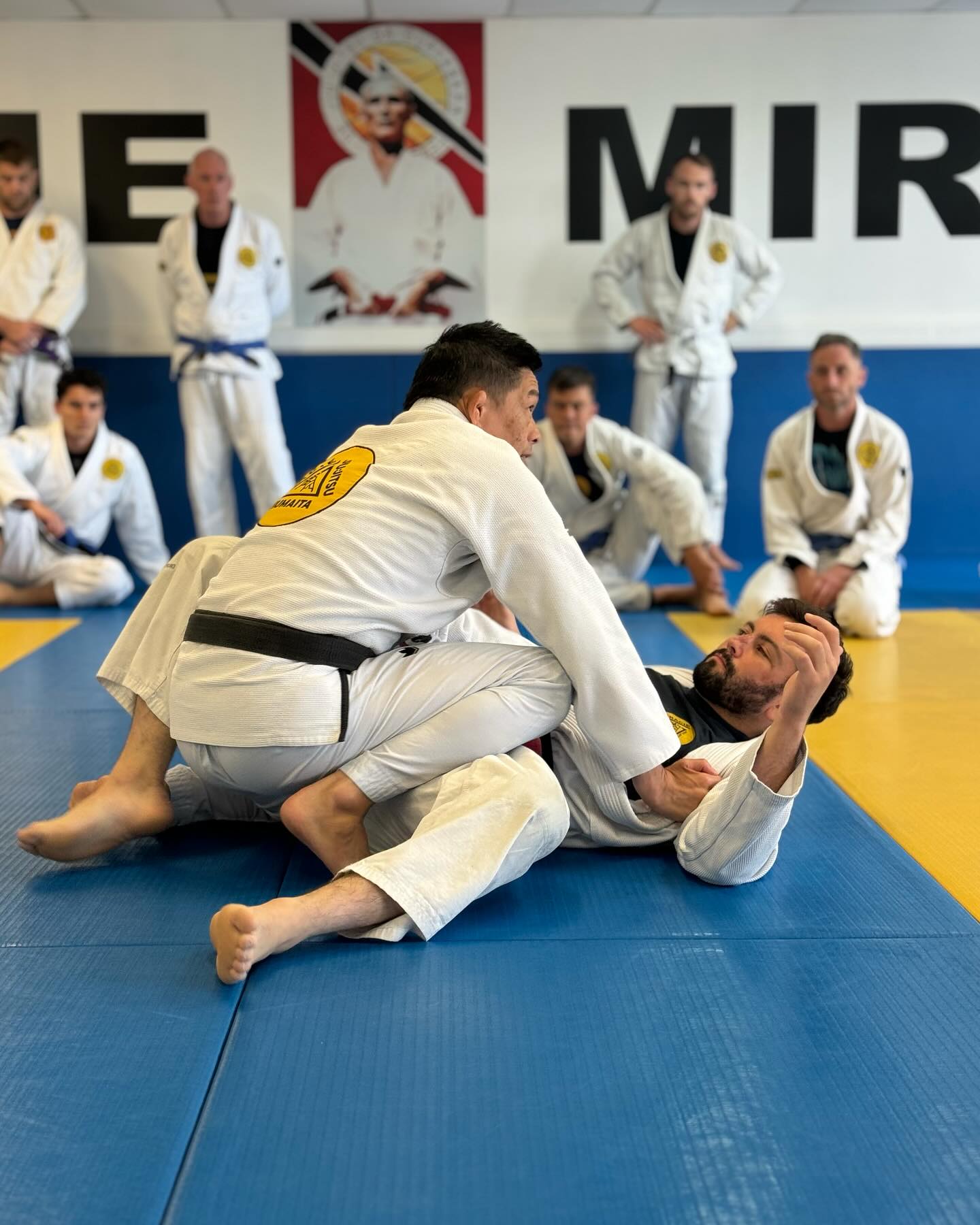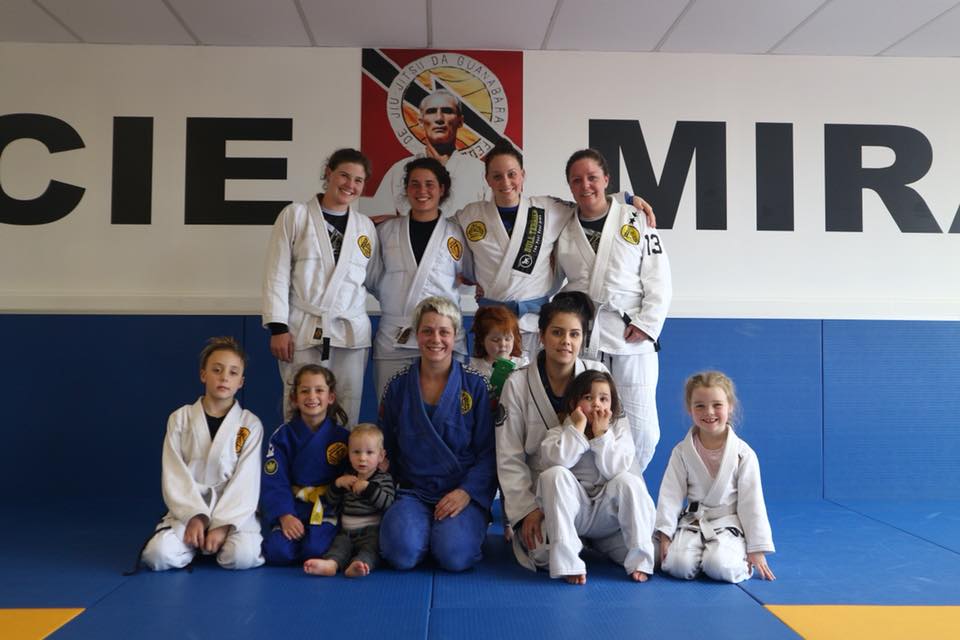Gracie Jiu Jitsu History
Birth
Jiu-Jitsu, unlike other martial arts, did not evolve from one source, tradition, or root; instead it has multiple roots and travelled through many Asian countries before its final development in Japan.
The development of Jiu-Jitsu techniques started around 5000 years ago. A Babylonian copper stand (see picture), dating from the third Millennium B.C. shows two men engaged in a grappling technique found in Jiu-Jitsu. Both men are trying to unbalance each other by controlling their opponent’s hips.
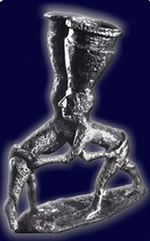
India
The Buddhist Monks who first began to develop Jiu Jitsu were men of great wisdom who possessed a perfect knowledge of the human body. Consequently, they applied laws of physics such as leverage, momentum, balance, centre of gravity, friction, weight transmission and manipulation of the human anatomy’s vital points in order to create a scientific art of self-defence.

The Art of the Samurai
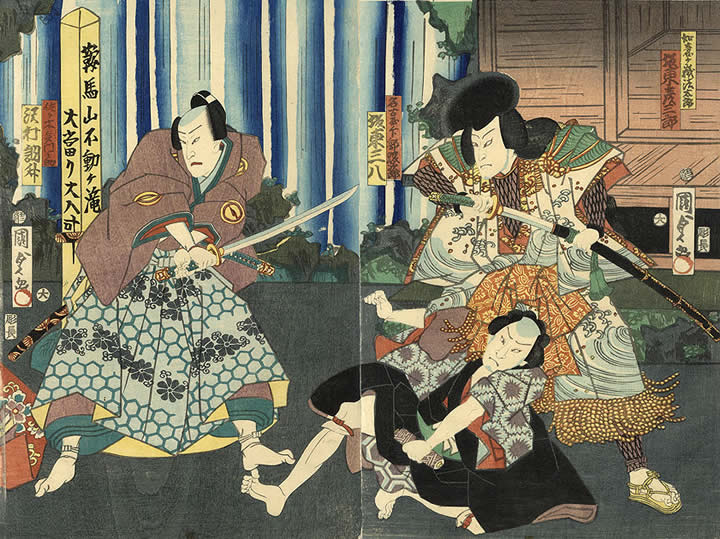
From India Jiu Jitsu travelled to China and then to Japan. The period of Japanese history between the 8th and 16th centuries was covered with constant civil war and many systems of Jiu-Jitsu were utilized, practiced and perfected on the battlefield. This training was used to conquer armoured and armed opponents.
Many close fighting techniques were created and mastered during this era. In 1532 HisamoriTenenuchi officially established the first school of Jiu-Jitsu in Japan.
In 1559, a Chinese monk named Chin Gen Pinh came to Japan, accompanied with his knowledge and experience of Kempo, known as the “China Hand.” Shortly after Chin Gen Pinh arrived in Japan, ideyoshiToyotomi also migrated to Japan from China, bringing with him Ch-anFa and Korean Tang Su, a punching and nerve striking skill and method of fighting. These skills were perfected and integrated into Jiu-Jitsu.
In approximately 1603, Japan came to a fairly peaceful period following the formation of the Tokugawa military government by Tokugawa Ieyasu. During this time (1603-1868), the feudal civil wars that had plagued Japan for centuries started to disappear. However, following the adage “living in peace, but remembering war,” the practice of jujitsu continued to spread. Forms and techniques displaying weapons skills of fighting began to yield to weaponless styles which incorporated many of the grappling ground fighting techniques of the older styles.
The traditions of classical budo (martial arts) required that everyone should learn a method of self-defense for those situations where weapons could not be used. Universally, these techniques were known as Jujutsu.
It has been estimated that there were about 725 recorded systems of jujutsu in vogue during its golden age from 1680 to 1850.
The Meiji Restoration of the Emperor replaced the feudal military regime established by Tokugawa Ieyasu in 1603.
This happened because growing internal unrest in the middle 1800’s convinced the shogun that returning of power to the Emperor was called for. During the Meiji period, with the collapse of the feudal system, Japan started to open up to western culture and customs.
Breakdown
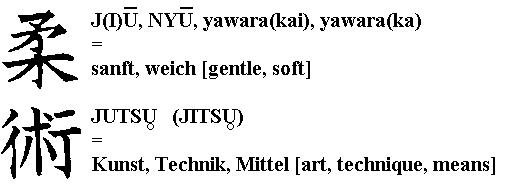
As the Japanese felt that it would be virtually impossible to hide the Jiu-Jitsu techniques from Westerners, they decided to break Jiu-Jitsu down into several styles with limited effectiveness in a real fight.
The arts of Karate, Judo, and Aikido were all developed from Jiu-Jitsu. These styles were transformed into sports in order to keep secret the most lethal and street effective techniques.
Mitsuyo Maeda – Conde Koma
Jiu Jitsu came to Brazil with a Japan’s champion Judoka and Jiu Jitsu fighter- Mitsuyo Maeda, as many Japanese people were immigrating to Brazil at that time. A Brazilian diplomat named Gastão Gracie helped the colony with land and cattle and also helped Koma secure citizenship in Brazil. In return for this help Koma went against the Japanese tradition and volunteered to teach real and effective Jiu-Jitsu to a non-Japanese, Gastão’s son Carlos.
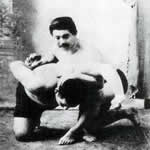
The Birth of Gracie Jiu Jitsu
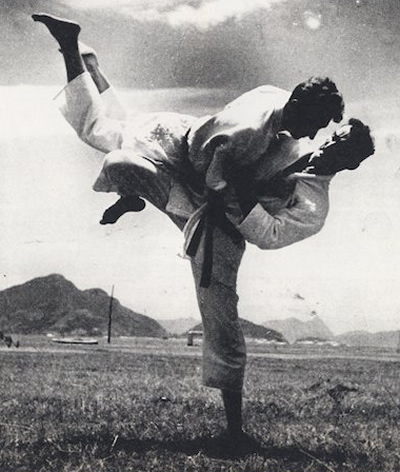 Hélio, Carlos’ youngest brother, was physically frail and would constantly faint when doing any type of physical activity. The family doctor advised Hélioto avoid any kind of exercise. Consequently, he would sit on the side of the mat watching Carlos teach classes. He did that for a couple of years. One day, when he was 16 years old, a student showed up for class, but Carlos was not around and Hélio said, “My brother is not here, but if you want, I can go through the techniques with you. I’ve been watching my brother for so long that I memorized all the moves.”
Hélio, Carlos’ youngest brother, was physically frail and would constantly faint when doing any type of physical activity. The family doctor advised Hélioto avoid any kind of exercise. Consequently, he would sit on the side of the mat watching Carlos teach classes. He did that for a couple of years. One day, when he was 16 years old, a student showed up for class, but Carlos was not around and Hélio said, “My brother is not here, but if you want, I can go through the techniques with you. I’ve been watching my brother for so long that I memorized all the moves.”
Hélio went through the moves with the student. He was so excited and enthusiastic about teaching the student that when Carlos arrived and apologized for being late the student said, “I’ve had a class with your brother and if you don’t mind from now on I’ll continue taking classes with him.” From that day on Hélio became an instructor and soon after he was teaching the vast majority of the classes while Carlos became more involved with the development of the Gracie Diet and guiding the fighting careers of his Gracie brothers.
In spite of his small frame and weight of only 140 pounds, Hélio became the mastermind behind the development of Gracie Jiu-Jitsu, adapting the techniques of Japanese Jiu-Jitsu so that they depended entirely upon leverage, rather than strength and explosiveness. He was driven by a constant determination to find effective ways to deal with every possible aspect of a real fight.
Daring to break away from the traditional Japanese style, he began experimenting, modifying and perfecting simple techniques that would be effective regardless of stature. That is how he developed this style of Jiu-Jitsu. Though Gracie Jiu-Jitsu descended from the ancient Japanese style, the differences are quite apparent. Many of the Japanese facets of the art, which depend on physical prowess and stiff motion, were tossed aside, leaving only pure technique.
Beginning of the Gracie Dynasty
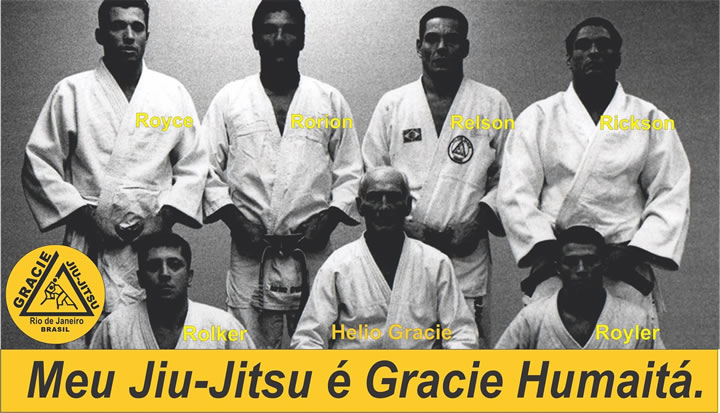
Rolker, Royce, Rorion, Helio, Relson, Rickson, Royler are all famous names from the Gracie clan’s legacy of fighters and martial artists that continued this practice.
At the age of 17, Hélio Gracie stepped into the ring for the first time in Rio de Janeiro against a professional boxer named Antonio Portugal. Hélio won this match via arm lock in approximately 30 seconds. This fight was the first of many victories that Hélio would have against opponents from around the world. Under the tutelage of his brother Carlos, Hélio went on to become a national hero in Brazil. Some of his astonishing feats include the longest fight in history: a three hours and forty-five minutes non-stop brawl with no rounds; and his fight against World Wrestling Champion Wladek Zybskus, who weighed 280 lbs.
Another amazing performance by Hélio was his brilliant fight against Kato, World Jiu-Jitsu lightweightchampion. The fight ended in a draw and Hélio asked for a rematch. The second match, held at Ibirapuera Arena in São Paulo, was a very technical fight.Hélio defeated Kato with a chokehold from the guard position. His victory brought glory to Brazil and international recognition to Gracie Jiu-Jitsu.
Upon defeating Kato, a challenge match was set between Hélio and the world open weight champion, Masahiko Kimura, probably the best Judo fighter that Japan has ever produced.
This historical match took place in 1955 and was held at Maracanã Stadium, which at the time, sat 200,000 people. Hélio was 42 years old and weighed 140 lbs. while Kimura was 34 years old and weighed 195 lbs.
Masahiko Kimura boldly stated that if Hélio could last more than 3 minutes, he should consider himself the winner. Hélio fought Kimura for 15 minutes before being caught in an arm lock. Fearful of having his brother’s arm shattered, Carlos Gracie threw in the towel.
Tremendously impressed with Hélio’s technique, the Japanese masters invited Hélio to come to Japan and teach. Respectfully, Hélio declined wishing to continue in Brazil the work that his family had begun.
Hélio also challenged boxing greats Primo Carnera and Ezzard Charles, and world champion Joe Louis, to matches to compare styles. They all declined. Throughout his career, Hélio defeated fighters from several different styles in order to prove the superiority of Gracie Jiu-Jitsu as a martial art.
An example of courage and determination, Hélio became a national hero in Brazil. After a lifetime of combat, he continued to teach the art and had the same determination to make jiu-jitsu his lifestyle and life purpose. He is recognized worldwide as the father of Gracie Jiu-Jitsu and passed away at peace with all this work on January 29th, 2009.
Latest
articles
Free Introduction Class
Brazilian Jiu Jitsu for Everyone!!
Thought of starting Brazilian Jiu Jitsu but are unsure if you would like this Martial Art?
Come train with us for free. Without obligation, no pressure!!
